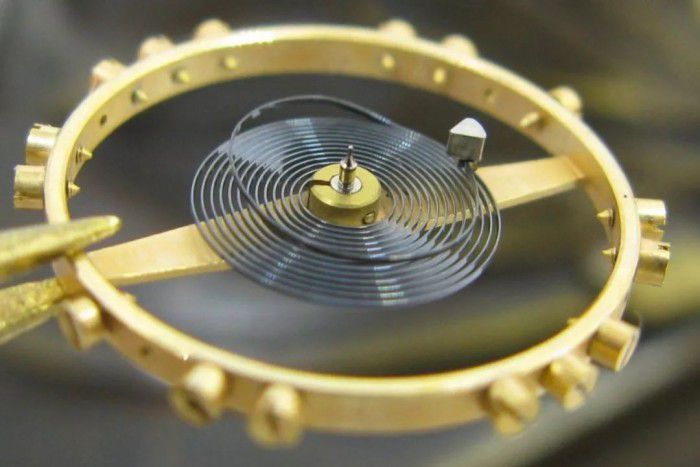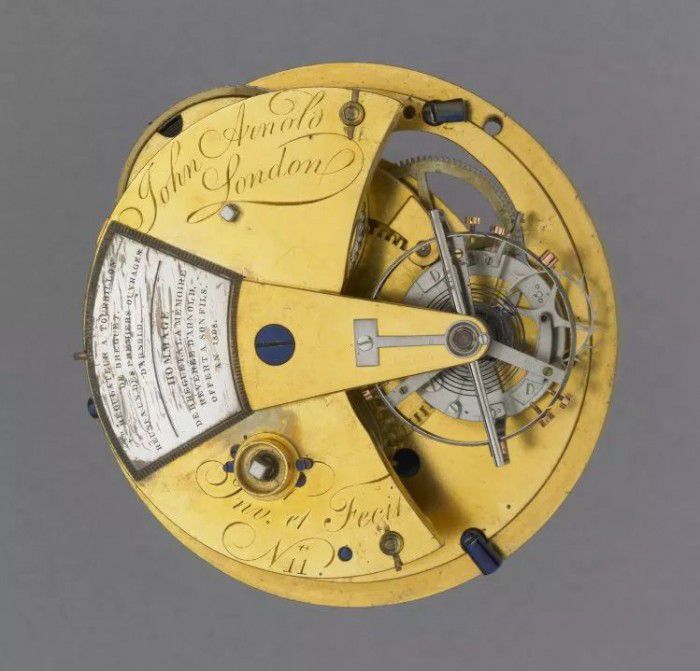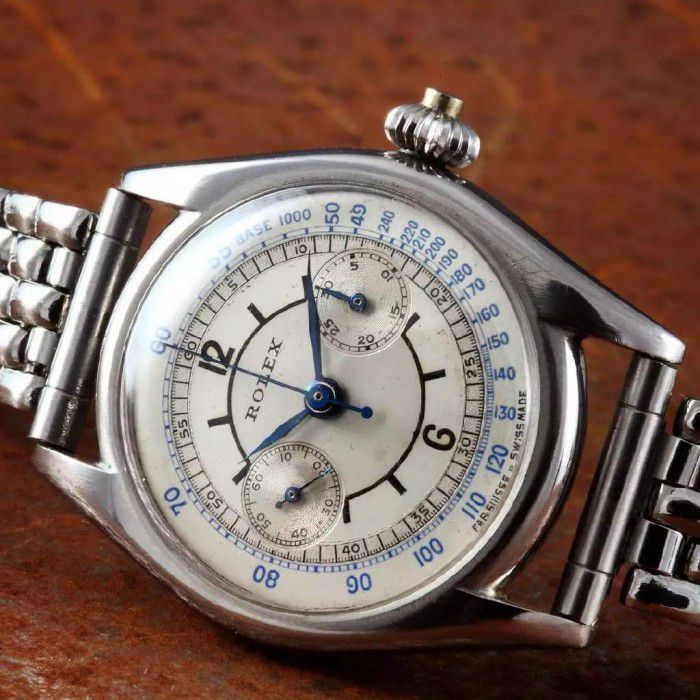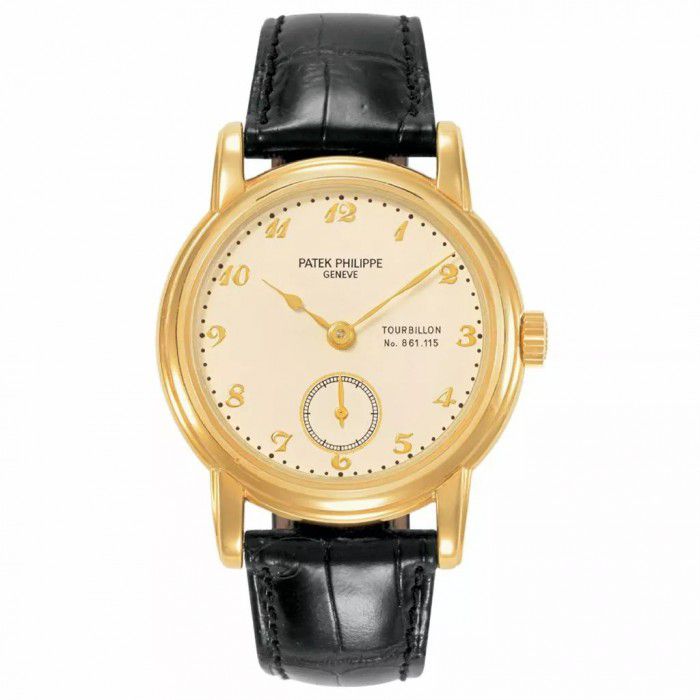
The mechanical clock movement uses a hairspring balance wheel speed regulation system, which directly determines the timekeeping accuracy of the clock. The hairspring is a circle of metal wire arranged according to the Archimedean spiral (similar to standard mosquito coils). With a hairspring arranged this way, its center of gravity is naturally not at its center.
When the hairspring is loaded onto the balance wheel, it will shrink and expand with the movement of the balance wheel. At this time, the shape of the hairspring will change. Wastchoosy used an 11x magnifying glass to shoot a slow-motion video of the movement of the balance spring. In the video, we can see that the shape of the hairspring is irregular when it shrinks and expands. The upper right corner shrinks and expands more than the lower left corner.
The shape of the hairspring changes during movement, and the center of gravity of the hairspring moves everywhere, deviating more than when stationary. This offset is subtle but intolerable for a hairspring balance system that operates nearly 500,000 times daily. A small amount of offset amplification will affect the timekeeping accuracy of the clock.

To solve this problem, Abraham-Louis Breguet, the founder of the watch brand Breguet, proposed in 1795 to bend part of the hairspring upward to form a double-layer hairspring and use the weight of the second layer of hairspring to balance the entire hairspring. A center of gravity is a method to keep the center of gravity as central as possible. This design later became known as the “Breguet Spring” Breguet hairspring.

On June 26, 1801, Abraham-Louis Breguet obtained a patent issued by the official organization, valid for ten years, named “Tourbillon Tourbillon”. Breguet envisaged installing the entire hairspring escapement speed regulating system in a movable frame that rotates one full circle per minute. In this way, all errors recur regularly and thus cancel each other out.
According to Breguet’s vision, the design of the tourbillon is very “perfect.” However, transitioning from invention design to physical object could be smoother sailing. Breguet obtained a patent in 1801 but only had experimental products then. It was not until four years later that the Tourbillon pocket watch was officially launched on the market, and it was not a mass-produced version but a customized one. From 1805 to the death of Abraham-Louis Breguet in 1823, Breguet sold only 35 tourbillon watches in 18 years. Compared to the sales performance of watches equipped with Breguet hairspring, the difference is enormous. Fake gold watches.

Why does this happen? That’s because it took more work to make a tourbillon based on the watch processing technology at the time. There is little power in the spring of the pocket watch movement, but now it has to drive a movable frame. Therefore, the movable frame of the tourbillon must be made very light, and the entire tourbillon frame should weigh less than 1 gram so that the gear train of the movement can move. Such a lightweight frame was challenging in that era when lathe processing technology was imperfect.
Moreover, even if the frame’s shape was made, the balance of the entire hairspring escapement system had to be considered. Therefore, the processing and production of tourbillon has always been a complex problem! According to records, more than 200 years after the invention of the tourbillon, only about 200 watchmakers mastered this advanced technology.
Because of its small quantity, difficulty in processing, and high value, the tourbillon is regarded as an “artifact” by many watch friends. There is often this thought: “Brands with tourbillons are great, brands without tourbillons are low-end.”
As for why Rolex doesn’t have a tourbillon? It can be divided into three stages to explore the reasons. The first stage is from 1905 to around the 1950s, the second is from 1953 to the 1990s, and the third is from the 1990s to the present.
The first stage: from 1905 to around the 1950s
Rolex cannot make a tourbillon due to a lack of ability

Single button chronograph Rolex Ref.2303
This explanation sounds incredible at first.
Hans Wilsdorf founded the predecessor of Rolex in 1905. In the following days, he relied on two magic weapons: an “Oyster waterproof case” + “self-winding movement” to open up the situation. But at this time, Rolex’s movement research, development, and production capabilities were not vital! Aegler produced Rolex’s movements at the time. Therefore, Rolex could not make it at that time.

Patek Philippe pocket watch using Albert Pellaton-Favre tourbillon movement
Not only could Rolex not make it, but at that time, few brands could independently produce tourbillon pocket watches and watches. Many tourbillon pocket watches from big brands such as Patek Philippe, Vacheron Constantin, Girard-Perregaux, and Ulysse Nardin are ordered and processed by watchmakers and then sold under their trademarks. The most famous watchmakers are Albert Pellaton-Favre (1832-1914) and his son James César Pellaton (1873-1954). This is why we find that the tourbillon pocket watches of these brands all look similar. Hublot replica.
Of course 1947, Omega developed the Cal.30L tourbillon watch movement; in 1956, Patek Philippe developed the Cal.34T tourbillon watch movement. However, at that time, they were all small-scale productions as observatory competitions and could not do it. To be used in mass production.
The second stage: from 1953 to around the 1990s
The product positioning is precise; Rolex does not need to make a tourbillon.

The predecessor of the Rolex Explorer series “Oyster Perpetual.”
Rolex’s most famous sports model is the ‘Submariner’ series, which originated in 1953 and is commonly known as the “Submariner” but is not the originator of Rolex sports models. In 1953, British expedition members wore Rolex Oyster Perpetual watches and successfully climbed Mount Everest for the first time. To commemorate this event, Rolex launched the “Explorer” series. After that, professional watches such as Rolex Submariner, GMT-Master, Milgauss, Daytona, Sea-Dweller, Explorer, and Yacht-Master were launched one after another and won market acceptance.
At this time, Rolex’s product positioning gradually became apparent, and it wanted to make accurate and reliable professional watches.
The third stage: 1990s to present
The brand status is established; Rolex disdains it and cannot make tourbillons.

This is a Patek Philippe with model number Ref. 3369; its owner is Philippe Stern, the former president of Patek Philippe. It looks like a small three-pin style, but it has much history.

From the mid-19th century to the mid-20th century, the Observatory Chronometer competition was held for nearly 100 years. All major watch brands came up with their best products to compete. This Patek Philippe Ref.3369 watch has a slight manual tourbillon movement numbered 861115. It was initially produced to participate in the Swiss Observatory Chronometer competition.
Because the information back then was on paper coupled with geopolitics, no systems needed to the beta was available online. Dr. Christian Müller from the Observatory Chronometer Database (OCD) uploaded all the detailed information of the 3,356 participating movements of the Neuchâtel Observatory from 1945 to 1967 to the website and provided free inquiry. Interested watchers can log on to www.observatory.watch to browse.
Through inquiries, we know that the 861115 movement equipped with a precision tourbillon received a comprehensive score of 16.73 that year. Omega, which also made a tourbillon movement, scored 12.1 and 18.22.
With such a result, the overall ranking among the 3,356 participating movements is already 2,000 or higher… (The lower the overall score, the more accurate the watch)
It is worth noting that the Observatory Chronometer observatory competition is only a static test and does not simulate the movement state faced by the movement after it is assembled into the watch. Therefore, regarding travel time accuracy, a tourbillon with a complex structure will be even worse in actual wear than in static observatory testing.
In this way, the tourbillon has no meaning at all for Rolex. The quartz crisis caused by Japan’s Seiko Seiko in the 1970s and 1980s reshuffled the entire world’s watchmaking industry, and the Swiss mechanical watchmaking industry was hit hard. Many brands went bankrupt, closed down, merged, sold, and downgraded at that time. Fortunately, Rolex survived this crisis. Moreover, during the crisis, Rolex kept its production standards high and completed the upgrade from the 30 series to the 31 series movement. So after the crisis, Rolex’s brand status began to be established, and its brand positioning gradually became straightforward to produce accurate and reliable watches.
The tourbillon could be considered the most advanced technology in 1801. To improve the watch’s accuracy, Breguet used a complex mechanical structure to compensate for offsetting the hairspring’s center of gravity. However, experiments have proven that the travel time accuracy of tourbillon watches is similar to that of ordinary watches. At the same time, the complex mechanical structure brings disadvantages such as high cost, instability, easy damage, complex maintenance, slow debugging, and expensive maintenance. After 200 years, it still does not exist. Change.
Tourbillon is a backward and high-risk technology for Rolex, which pursues precision and reliability. Instead of producing “delicate” tourbillons now, “win with stability.”